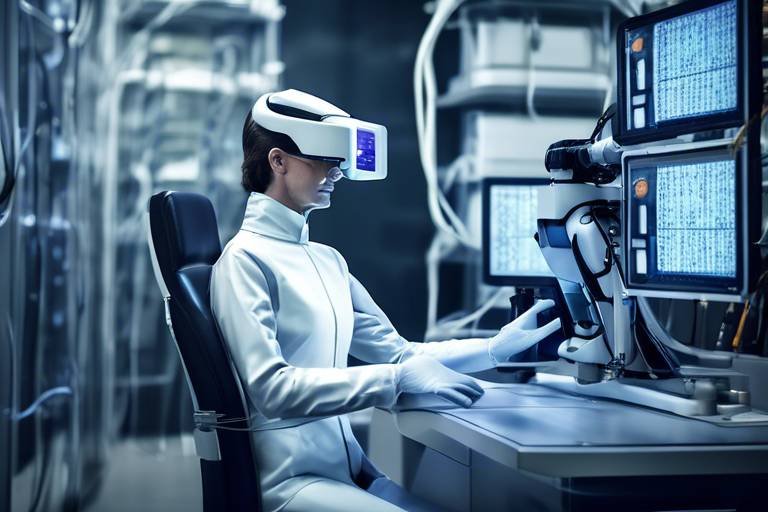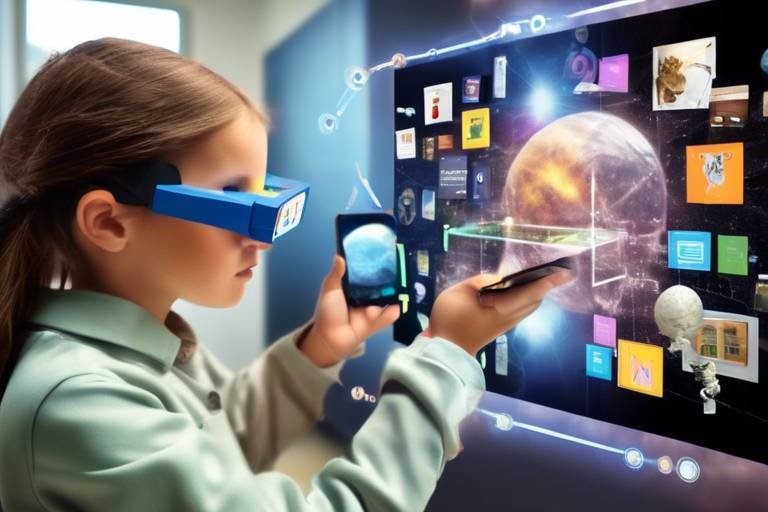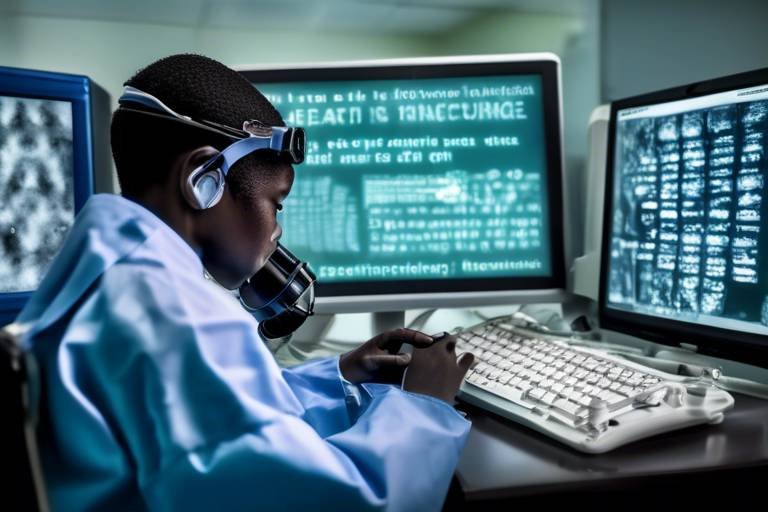The Role of Technology in Behavioral Health Interventions
In today's fast-paced world, the intersection of technology and behavioral health is not just a trend; it's a revolution. Imagine being able to access mental health care from the comfort of your home, without the stigma or barriers that often accompany traditional therapy. This article explores how technology enhances behavioral health interventions, examining its impact on treatment accessibility, patient engagement, and innovative tools that support mental health care. With the rise of teletherapy, mobile health applications, and wearable technology, we are witnessing a transformation that makes mental health resources more reachable than ever before.
Technology has truly revolutionized access to behavioral health services. Gone are the days when geographical location or transportation issues could hinder someone from seeking help. With just a smartphone or computer, individuals can now connect with mental health professionals from anywhere in the world. This shift not only reduces the barriers related to physical distance but also tackles the stigma associated with seeking help. For many, the idea of visiting a therapist's office can be daunting. However, technology allows for a more private and comfortable environment, where individuals can feel safe to open up.
Among the most significant advancements in behavioral health is the emergence of teletherapy, which enables therapists to connect with clients via video calls. This innovative approach has expanded the reach of mental health support, providing convenience and flexibility for patients. Imagine being able to attend a therapy session during your lunch break or from the comfort of your couch! Teletherapy is not just convenient; it’s a lifeline for those who may have previously felt isolated or unable to access care.
Teletherapy offers numerous benefits that cater to the diverse needs of patients. Some of these advantages include:
- Flexibility in scheduling: Clients can choose times that work best for them, making it easier to fit therapy into busy lives.
- Increased comfort: Many clients find it easier to open up in a familiar environment, leading to more productive sessions.
- Continuity of care: During challenging times, such as pandemics or personal crises, teletherapy ensures that individuals can maintain their therapeutic relationships.
Despite its advantages, teletherapy is not without challenges. Issues such as technology access disparities can create barriers for some individuals, particularly those in underserved communities. Additionally, potential privacy concerns arise when discussing sensitive topics over digital platforms. Therapists must also adapt to new modes of communication, which can be a learning curve for many. It’s essential to address these challenges to maximize the benefits of teletherapy.
As technology continues to evolve, so too will teletherapy. Future trends may include advanced features like AI-driven assessments that can help therapists better understand their clients' needs. Additionally, virtual reality environments could be incorporated into therapy sessions, providing immersive experiences that enhance the therapeutic process. The possibilities are endless, and the future of teletherapy looks promising!
Mobile health applications are becoming increasingly popular tools for managing mental health. These apps provide users with various resources, including mood tracking, mindfulness exercises, and direct communication with healthcare providers. Imagine having a personal mental health assistant right in your pocket! These applications empower individuals to take charge of their well-being by offering immediate support and resources at their fingertips.
Wearable devices, such as fitness trackers and smartwatches, are now being utilized to monitor physiological indicators of mental health. These devices can track metrics like heart rate and sleep patterns, providing valuable data to clinicians. This information not only helps clinicians understand their patients better but also empowers users to take charge of their health. Think of it as having a personal health coach that reminds you to take a break or practice breathing exercises when stress levels rise.
As wearable technology collects sensitive health data, privacy concerns inevitably arise. Users must be assured that their information is protected by clear guidelines and robust security measures. Maintaining trust in these innovative tools is crucial for their success. Without trust, individuals may hesitate to use these technologies, undermining their potential benefits.
Integrating technology with traditional therapeutic approaches can significantly enhance treatment effectiveness. By allowing for personalized interventions and real-time feedback, technology can lead to better patient outcomes in behavioral health. Imagine a scenario where your therapist can monitor your progress through an app and adjust your treatment plan accordingly. This kind of synergy between technology and traditional therapy could redefine how we approach mental health care.
Q: How does teletherapy work?
A: Teletherapy involves connecting with a therapist through video calls, phone calls, or messaging, allowing for therapy sessions to take place remotely.
Q: Is teletherapy as effective as in-person therapy?
A: Many studies suggest that teletherapy can be just as effective as in-person therapy, particularly for those who may feel more comfortable in a familiar environment.
Q: What types of mobile health applications are available?
A: There are numerous apps available for mood tracking, mindfulness, stress management, and even direct communication with therapists.
Q: Are wearable devices safe to use?
A: While wearable devices can provide valuable health data, it's essential to choose products from reputable companies that prioritize data privacy and security.

Improving Accessibility to Care
Technology has truly revolutionized the way we access behavioral health services. Imagine being able to connect with a mental health professional without the stress of commuting or waiting in a crowded office. This is the power of technology—it breaks down barriers that once seemed insurmountable. For many, the traditional stigma associated with seeking help can deter them from accessing the care they need. However, with the advent of telehealth and online resources, this stigma is gradually fading away.
One of the most significant advantages of technology in behavioral health is its ability to offer care remotely. No longer do individuals have to worry about finding transportation or taking time off work to attend appointments. With just a smartphone or computer, patients can engage in therapy sessions from the comfort of their homes. This flexibility not only saves time but also makes therapy more accessible to those who may have previously felt isolated due to geographical limitations.
But how does this accessibility translate into real-world benefits? Here are a few key points:
- Location Independence: Patients can connect with therapists regardless of their physical location, making it easier for those in rural or underserved areas to access quality care.
- Reduced Wait Times: With online platforms, patients can often find available therapists more quickly than traditional methods, leading to faster access to necessary support.
- Increased Comfort: Many individuals feel more at ease discussing personal issues in a familiar environment, which can lead to more open and productive sessions.
Moreover, technology fosters a sense of community. Online support groups and mental health forums allow individuals to connect with others who share similar experiences. This sense of belonging can be incredibly therapeutic and encourages individuals to seek help when they might otherwise hesitate.
As we look to the future, the integration of technology in behavioral health interventions promises even more exciting developments. Imagine a world where AI algorithms analyze patient data to recommend tailored treatment plans or where virtual reality environments simulate therapeutic scenarios for exposure therapy. The potential is vast, and as we continue to embrace these innovations, we can expect to see an even greater improvement in accessibility to care.
In conclusion, technology is not just a tool; it is a bridge that connects individuals to the mental health care they need. By breaking down geographical and social barriers, it empowers patients and providers alike, creating a more inclusive and effective healthcare landscape.
Q: How does technology improve accessibility to mental health services?
A: Technology allows for remote consultations, reducing geographical and transportation barriers, making it easier for patients to access care.
Q: Are there any downsides to using technology for mental health care?
A: While there are many benefits, challenges such as technology access disparities and privacy concerns remain important considerations.
Q: Can online therapy be as effective as in-person therapy?
A: Many studies suggest that online therapy can be just as effective as traditional therapy, especially when patients feel comfortable in their environment.

Teletherapy and Virtual Counseling
In recent years, teletherapy has emerged as a game-changer in the realm of behavioral health. Imagine being able to attend a therapy session from the comfort of your own home, still in your pajamas, sipping your favorite tea. Sounds great, right? This shift towards virtual counseling has not only made therapy more accessible but has also transformed how we think about mental health care. With just a few clicks, individuals can connect with licensed therapists through video calls, breaking down the traditional barriers that once made seeking help a daunting task.
One of the most significant advantages of teletherapy is its ability to reach people who may have previously felt isolated or unable to access care due to geographical constraints. Whether someone lives in a remote area or simply struggles with transportation, teletherapy provides a lifeline. In fact, studies have shown that individuals living in rural communities are now more likely to engage with mental health services than ever before, thanks to the convenience of virtual counseling.
Moreover, teletherapy offers a level of comfort that traditional face-to-face sessions might not provide. Clients can choose their environment, which can lead to a more relaxed and open dialogue. This flexibility can be especially beneficial for those dealing with anxiety or social phobias. In addition, the ability to schedule sessions at more convenient times means that therapy can fit more seamlessly into a person’s life, reducing the stress of juggling work, family, and mental health needs.
However, it's essential to acknowledge that teletherapy is not without its challenges. While the technology has made therapy more accessible, there are still disparities in access to reliable internet and devices. This situation can create a digital divide where some individuals are left without the support they need. Additionally, privacy concerns are paramount; clients must feel secure that their sessions are confidential and protected from potential breaches. Thus, therapists must prioritize creating a safe virtual space where clients can express themselves freely.
As we look to the future, the landscape of teletherapy is poised for exciting developments. Innovations such as AI-driven assessments could help therapists gain deeper insights into their clients' needs even before the session begins. Furthermore, the integration of virtual reality environments could provide immersive therapeutic experiences, allowing clients to confront their fears or practice coping strategies in a controlled setting. This evolution not only enhances the therapeutic experience but also broadens the horizons of what mental health care can look like.
In summary, teletherapy and virtual counseling are reshaping the way we approach mental health care. With its potential to improve accessibility, provide comfort, and embrace innovative technologies, teletherapy stands as a beacon of hope for many seeking support. As we navigate this digital age, it's crucial that we continue to address the challenges while celebrating the advancements, ensuring that everyone has the opportunity to prioritize their mental well-being.
- What is teletherapy? Teletherapy is a form of therapy conducted through digital platforms, allowing clients to connect with therapists via video calls, phone calls, or messaging.
- Is teletherapy as effective as in-person therapy? Research suggests that teletherapy can be just as effective as traditional face-to-face therapy for many individuals, particularly when it comes to convenience and accessibility.
- What technology do I need for teletherapy? Typically, you need a device with internet access, such as a smartphone, tablet, or computer, along with a video conferencing application.
- Are my sessions confidential? Yes, reputable teletherapy services prioritize client confidentiality and employ secure platforms to protect your information.

Benefits of Teletherapy
This article explores how technology enhances behavioral health interventions, examining its impact on treatment accessibility, patient engagement, and innovative tools that support mental health care.
Technology has revolutionized access to behavioral health services, allowing patients to receive care remotely and reducing barriers related to location, transportation, and stigma associated with seeking help.
Teletherapy has emerged as a vital tool in behavioral health, enabling therapists to connect with clients via video calls, thus expanding the reach of mental health support and improving convenience for patients.
Teletherapy offers a multitude of benefits that can significantly improve the mental health care experience. One of the most notable advantages is the flexibility in scheduling. Clients can book sessions that fit their busy lives, whether it’s during a lunch break or after the kids have gone to bed. This flexibility can lead to higher attendance rates and better engagement in therapy.
Additionally, teletherapy provides an increased sense of comfort for many clients. Being in a familiar environment, such as their own home, can help reduce anxiety associated with attending a traditional therapy session. Imagine sitting on your couch, wrapped in your favorite blanket, discussing your feelings with a therapist—sounds a lot less intimidating, right?
Moreover, teletherapy plays a crucial role in maintaining continuity of care, especially during challenging times like pandemics or personal crises. Clients can continue their treatment without interruption, ensuring they have the support they need when they need it the most. This is especially important for individuals who may struggle with the motivation to seek help in person.
Some additional benefits include:
- Wider access to specialists: Patients can connect with therapists who specialize in their specific needs, regardless of geographical barriers.
- Cost-effectiveness: Many teletherapy services are more affordable than in-person sessions, helping to reduce financial stress.
- Reduced stigma: The anonymity of online therapy can make it easier for individuals to seek help without fear of judgment.
In essence, teletherapy not only enhances accessibility but also promotes a more personalized and comfortable therapeutic experience, making it an invaluable resource in the realm of behavioral health.
Despite its advantages, teletherapy faces challenges such as technology access disparities, potential privacy concerns, and the need for therapists to adapt to new modes of communication effectively.
As technology evolves, teletherapy is likely to incorporate advanced features like AI-driven assessments and virtual reality environments, enhancing the therapeutic experience and broadening treatment possibilities.
Mobile health applications are becoming increasingly popular for managing mental health, providing users with tools for mood tracking, mindfulness exercises, and direct communication with healthcare providers.
Wearable devices, such as fitness trackers and smartwatches, are now being utilized to monitor physiological indicators of mental health, offering valuable data to clinicians and empowering users to take charge of their well-being.
As wearable technology collects sensitive health data, privacy concerns arise. Clear guidelines and robust security measures are essential to protect users' information and maintain trust in these innovative tools.
Integrating technology with traditional therapeutic approaches can enhance treatment effectiveness, allowing for personalized interventions and real-time feedback, ultimately leading to better patient outcomes in behavioral health.
Q: What is teletherapy?
A: Teletherapy is a form of therapy that occurs through video calls or other online platforms, allowing clients to receive mental health support remotely.
Q: Is teletherapy as effective as in-person therapy?
A: Research suggests that teletherapy can be just as effective as traditional in-person therapy for many individuals, especially when it comes to accessibility and comfort.
Q: What technology do I need for teletherapy?
A: Generally, you will need a device with a camera and internet access, such as a smartphone, tablet, or computer, along with a stable internet connection.

Challenges of Teletherapy
While teletherapy has opened up a world of possibilities for mental health care, it is not without its challenges. One of the most significant hurdles is the digital divide. Not everyone has equal access to the necessary technology, such as high-speed internet and compatible devices. This disparity can create a barrier for individuals who could greatly benefit from teletherapy but lack the means to participate. Imagine wanting to attend a concert but not being able to afford the ticket; it feels similar when someone is eager for help but can't connect due to technological limitations.
Another concern is privacy and confidentiality. Many patients worry about the security of their personal information when using teletherapy platforms. The fear of being overheard during a session or having sensitive data compromised can deter individuals from seeking help. It's crucial for therapists and platforms to emphasize the measures they take to protect patient information, ensuring a safe space for open communication.
Moreover, the need for therapists to adapt to new modes of communication can pose a challenge. Unlike in-person sessions, where non-verbal cues are easily observed, teletherapy requires a different skill set. Therapists must be proficient in using technology while also maintaining a strong therapeutic alliance with their clients. This adjustment can be daunting, especially for seasoned professionals who are accustomed to traditional methods.
Additionally, some clients may experience technical difficulties during sessions, which can disrupt the flow of therapy. Issues such as poor video quality, audio lag, or connectivity problems can lead to frustration for both the therapist and the client. In these moments, the therapeutic process can feel less effective, akin to trying to have a conversation in a noisy cafe where you can barely hear each other.
Lastly, there is the concern of engagement and motivation. In a virtual setting, clients may find it easier to become distracted or disengaged compared to face-to-face interactions. Therapists need to develop strategies to keep clients motivated and focused during sessions, which can be a challenge when the comfort of home is filled with potential distractions.
Despite these challenges, the potential of teletherapy remains vast. By acknowledging and addressing these issues, both therapists and clients can work together to create a more effective and supportive teletherapy experience.
- What is teletherapy? Teletherapy is a form of therapy conducted over digital platforms, allowing clients to connect with therapists through video calls, phone calls, or messaging.
- Is teletherapy as effective as in-person therapy? Many studies suggest that teletherapy can be just as effective as traditional in-person therapy, though individual experiences may vary.
- What technology do I need for teletherapy? Typically, you will need a device with a camera and microphone, a stable internet connection, and access to a secure teletherapy platform.
- Are my sessions confidential? Yes, most teletherapy platforms prioritize client confidentiality and employ security measures to protect your information.
- Can teletherapy be used for crisis situations? While teletherapy can provide immediate support, it may not be suitable for severe crises. In such cases, in-person intervention may be necessary.

Future Trends in Teletherapy
The landscape of teletherapy is rapidly evolving, and as we look to the future, several exciting trends are emerging that promise to enhance the therapeutic experience for both clients and therapists. One of the most significant advancements is the integration of artificial intelligence (AI) into teletherapy platforms. Imagine having an AI-driven system that can conduct preliminary assessments, analyze patient data, and even provide personalized recommendations based on individual needs. This technology could streamline the initial stages of therapy, allowing therapists to focus on more complex aspects of treatment.
Another trend gaining traction is the use of virtual reality (VR) environments in therapeutic settings. Picture this: a client struggling with anxiety can enter a controlled VR environment that simulates real-world scenarios, helping them confront their fears in a safe space. This immersive experience can be a game-changer for exposure therapy, making it more engaging and effective. As VR technology continues to improve, its applications in mental health care are likely to expand, offering new avenues for treatment.
Furthermore, the incorporation of wearable technology is set to revolutionize teletherapy. Devices like smartwatches can monitor physiological responses such as heart rate and stress levels in real-time. By integrating this data into teletherapy sessions, therapists can gain valuable insights into a client's emotional state, allowing for more tailored interventions. This real-time feedback loop not only enhances the therapeutic process but also empowers clients to take an active role in their mental health management.
Moreover, the future of teletherapy will likely see an increase in collaborative care models. These models emphasize teamwork among various healthcare providers, including therapists, physicians, and nutritionists. Teletherapy platforms will increasingly support multi-disciplinary approaches, where clients can receive comprehensive care that addresses both mental and physical health needs. This holistic approach not only improves patient outcomes but also fosters a sense of community and support among providers and clients alike.
As we embrace these future trends, it is crucial to address potential challenges, such as ensuring data privacy and maintaining the therapeutic alliance in a virtual environment. However, with careful planning and the right tools, the future of teletherapy holds immense potential to make mental health care more accessible, effective, and engaging. The integration of technology into therapy is not just a trend; it's a transformation that could redefine how we approach mental health treatment for generations to come.
- What is teletherapy?
Teletherapy is a form of therapy conducted via digital platforms, allowing clients to connect with therapists remotely through video calls, phone calls, or messaging.
- How does teletherapy work?
Clients schedule appointments with their therapists, and during the sessions, they communicate through a secure online platform, discussing their concerns just as they would in person.
- Is teletherapy effective?
Research indicates that teletherapy can be as effective as traditional in-person therapy, especially for certain conditions like anxiety and depression.
- What are the benefits of teletherapy?
Teletherapy offers flexibility, convenience, and accessibility, making it easier for individuals to seek help from the comfort of their homes.
- Are there any downsides to teletherapy?
Some challenges include technology access disparities, potential privacy concerns, and the need for therapists to adapt their communication styles.

Mobile Health Applications
In today's fast-paced world, have emerged as game-changers in the realm of behavioral health. These apps are not just trendy gadgets; they are powerful tools that empower individuals to take charge of their mental well-being. Imagine having a personal therapist in your pocket—accessible at any time and tailored to your unique needs. With just a few taps on your smartphone, you can engage with resources that help you manage stress, anxiety, and depression.
One of the most exciting aspects of mobile health apps is their ability to provide real-time support. For instance, users can track their moods, identify triggers, and even access guided meditation sessions—all from the comfort of their own homes. This immediacy is crucial because it allows individuals to address their mental health challenges as they arise, rather than waiting for a scheduled appointment. Furthermore, many of these applications offer features such as:
- Mood Tracking: Users can log their feelings throughout the day, helping them recognize patterns and correlations between their emotions and daily activities.
- Mindfulness Exercises: Many apps include guided meditations, breathing exercises, and other relaxation techniques to help users cultivate a sense of calm.
- Direct Communication: Some applications allow users to connect with healthcare providers, making it easier to seek help when needed.
Moreover, the integration of artificial intelligence (AI) in these applications is paving the way for personalized experiences. Imagine an app that learns from your interactions and suggests tailored exercises based on your mood patterns. This level of customization not only enhances user engagement but also fosters a deeper understanding of one’s mental health journey.
However, with great power comes great responsibility. While these apps can be incredibly beneficial, it's essential for users to be mindful of their privacy and data security. Many health apps collect sensitive information, which raises questions about how that data is stored and used. Developers must implement robust security measures to protect users' information and maintain their trust. Transparency about data usage and clear privacy policies will go a long way in ensuring users feel safe while utilizing these innovative tools.
As we look to the future, the potential for mobile health applications in behavioral health is immense. The ongoing evolution of technology will likely lead to even more sophisticated features, such as virtual support groups and AI-driven therapy sessions. The combination of technology and mental health care is not just a trend; it’s a revolution that is making mental health support more accessible and engaging than ever before.
Q: What are mobile health applications?
A: Mobile health applications are software programs designed to help users manage their health and well-being through their smartphones. They can include features for tracking moods, providing mindfulness exercises, and facilitating communication with healthcare providers.
Q: Are mobile health apps effective for mental health management?
A: Yes, many studies suggest that mobile health apps can be effective in helping individuals manage their mental health by providing tools for self-monitoring, education, and direct support.
Q: How can I ensure my data is secure when using health apps?
A: To ensure your data is secure, choose apps that have strong privacy policies, utilize encryption, and provide clear information on how your data will be used. Always read user reviews and check for security certifications.
Q: Can mobile health apps replace traditional therapy?
A: While mobile health apps can complement traditional therapy by providing additional support and resources, they are not a replacement for professional mental health care. It’s important to seek help from qualified professionals when needed.

Wearable Technology in Mental Health
Wearable technology has taken the world by storm, and its impact on mental health is nothing short of revolutionary. Imagine having a small device on your wrist that not only tracks your physical activity but also provides insights into your emotional well-being. This is the reality that wearable devices, such as fitness trackers and smartwatches, have brought into our lives. These gadgets are not just for counting steps; they are now being used to monitor physiological indicators like heart rate variability, sleep patterns, and even stress levels. By gathering this data, wearables empower users to take charge of their mental health in ways that were previously unimaginable.
One of the most exciting aspects of wearable technology in mental health is its potential to provide real-time feedback. For instance, a smartwatch can alert you when your heart rate spikes, which might be a sign of anxiety. This immediate feedback allows individuals to recognize their emotional responses and take proactive steps to manage their mental health. Moreover, this data can be shared with healthcare providers, giving them valuable insights into a patient's mental state. This kind of information can lead to more personalized treatment plans, making therapy more effective.
However, the integration of wearable technology into mental health care is not without its challenges. One major concern is data privacy. As these devices collect sensitive health information, it is crucial to ensure that users' data is protected. Clear guidelines and robust security measures must be implemented to maintain trust in these innovative tools. Patients need to feel confident that their personal information is secure, or they may be hesitant to fully engage with these technologies.
Despite these challenges, the potential benefits of wearable technology in mental health are immense. For instance, studies have shown that individuals who use wearable devices to monitor their mental health report higher levels of self-awareness and engagement in their treatment. This increased awareness can lead to better coping strategies and improved overall well-being.
As wearable technology continues to evolve, we can expect to see even more innovative applications in mental health care. From integrating artificial intelligence to predict mental health crises to developing virtual reality environments that promote relaxation and mindfulness, the future looks promising. It’s like having a personal mental health assistant right on your wrist, ready to help you navigate life’s challenges.
In conclusion, wearable technology is transforming the landscape of mental health care. By providing users with the tools to monitor their emotional well-being and offering healthcare providers valuable data, these devices are paving the way for a more proactive and personalized approach to mental health treatment. As we embrace this technology, it is essential to prioritize data privacy and security to ensure that users can benefit from these advancements without compromising their personal information.
- What types of wearable devices are used for mental health tracking? Wearable devices like fitness trackers, smartwatches, and specialized mental health monitors are commonly used to track indicators such as heart rate, sleep quality, and stress levels.
- How can wearable technology improve mental health treatment? Wearable technology provides real-time data that helps users and healthcare providers make informed decisions about treatment, leading to more personalized and effective care.
- Are there privacy concerns with using wearable technology? Yes, privacy is a significant concern as these devices collect sensitive health data. It is crucial for manufacturers to implement strong security measures to protect users' information.
- Can wearable devices replace traditional therapy? While wearables can enhance mental health treatment, they are not a replacement for traditional therapy. They serve as complementary tools that provide additional support and insights.

Data Privacy Concerns
As the use of wearable technology in mental health care continues to rise, have become a significant topic of discussion. These devices, which track everything from heart rates to sleep patterns, collect a wealth of sensitive information that can reveal much about an individual's mental state. This raises an important question: how secure is the data being collected? The reality is that while these technologies can offer invaluable insights into our mental health, they also present risks that both users and providers must navigate.
One of the primary concerns revolves around the potential for data breaches. With cyberattacks becoming increasingly sophisticated, the risk that personal health information could be compromised is a real threat. Imagine a scenario where a hacker gains access to your mental health data; not only could this information be misused, but it could also lead to significant emotional distress for the individual involved. Therefore, it is crucial for both developers and users to prioritize data security measures.
To address these concerns, several key strategies can be employed:
- Encryption: Ensuring that data is encrypted both in transit and at rest can help protect sensitive information from unauthorized access.
- Clear Privacy Policies: Users should have access to transparent privacy policies that outline how their data will be used, stored, and shared.
- User Control: Implementing features that allow users to control their data, including the ability to delete it, can enhance trust in these technologies.
Furthermore, regulatory frameworks, such as the Health Insurance Portability and Accountability Act (HIPAA) in the United States, play a vital role in safeguarding personal health information. Compliance with such regulations not only protects users but also enhances the credibility of the technology providers. However, the challenge lies in ensuring that all wearable technology companies adhere to these regulations, as the landscape is filled with various players, some of whom may not prioritize data security.
Ultimately, as we embrace the benefits of wearable technology in mental health, we must also remain vigilant about the associated privacy risks. Engaging in open conversations about these concerns and advocating for stronger data protection measures will be essential in fostering a safe environment for users. The future of mental health care is bright with technology, but it is our responsibility to ensure that it is also secure.
- What types of data do wearable devices collect? Wearable devices can collect a variety of data, including heart rate, sleep patterns, physical activity levels, and even mood tracking.
- How is my data protected? Data protection can vary by device, but reputable companies typically use encryption and comply with data protection regulations to safeguard user information.
- Can I delete my data from wearable devices? Most wearable devices allow users to delete their data, but the process may differ depending on the manufacturer.

Integration with Traditional Therapies
Integrating technology with traditional therapies is like adding a turbocharger to a well-tuned engine; it enhances performance and efficiency. In the realm of behavioral health, this integration creates a dynamic synergy that not only improves treatment outcomes but also makes the therapeutic process more engaging for clients. Traditional therapies, such as cognitive-behavioral therapy (CBT) and dialectical behavior therapy (DBT), have long been the cornerstone of mental health treatment. However, when paired with modern technology, they can reach new heights.
For instance, therapists can now utilize mobile applications to monitor a client's progress in real-time. Imagine a client engaging in CBT exercises through an app that provides immediate feedback or prompts them to reflect on their thoughts and feelings throughout the day. This level of interaction keeps clients accountable and encourages them to actively participate in their healing journey, rather than waiting for the next session to discuss their progress.
Moreover, technology allows for the collection of valuable data that can inform treatment plans. By analyzing patterns in a client's mood, behavior, and responses to various stimuli, therapists can tailor their approaches to meet individual needs more effectively. For example, a therapist might notice that a client tends to feel anxious during specific times of the day or in particular environments. With this insight, they can develop targeted strategies to help the client cope with these triggers.
Another exciting aspect of this integration is the use of virtual reality (VR) in exposure therapy. VR can simulate environments that trigger anxiety or phobias, allowing clients to confront their fears in a controlled and safe space. This immersive experience can be far more impactful than traditional methods, as it engages multiple senses and provides a realistic scenario for clients to navigate.
However, it's essential to approach this integration thoughtfully. Not all clients may feel comfortable using technology as part of their therapy, and some may even feel overwhelmed by it. Thus, therapists must assess each client's readiness and willingness to engage with these tools. The goal should always be to enhance the therapeutic experience, not to replace the human connection that is so vital in mental health care.
In conclusion, the integration of technology with traditional therapies offers an exciting frontier in behavioral health. By leveraging the strengths of both worlds, therapists can provide more personalized, effective, and engaging treatment options. As we move forward, it will be crucial to remain mindful of the balance between technology and the essential human touch that defines successful therapy.
- How does technology improve therapy? Technology enhances therapy by providing tools for real-time monitoring, increasing accessibility, and offering innovative treatment methods like virtual reality.
- Are there risks associated with using technology in therapy? Yes, potential risks include privacy concerns, technology access disparities, and the need for clients to adapt to new methods of communication.
- Can all clients benefit from technology in therapy? Not necessarily. Each client's comfort level with technology varies, and it's essential for therapists to assess individual needs and preferences.
Frequently Asked Questions
- What is teletherapy and how does it work?
Teletherapy is a form of therapy conducted over video calls, allowing therapists to connect with clients from the comfort of their own homes. It works by using secure online platforms that facilitate real-time communication, making mental health support more accessible than ever.
- How has technology improved accessibility to behavioral health care?
Technology has significantly improved accessibility by removing geographical barriers, enabling remote consultations, and reducing the stigma often associated with seeking mental health help. Patients can now receive care without the need for travel, making it easier to prioritize their mental well-being.
- What are the benefits of using mobile health applications?
Mobile health applications offer a variety of benefits, including mood tracking, mindfulness exercises, and direct communication with healthcare providers. These tools empower users to take an active role in managing their mental health and provide valuable insights to their therapists.
- Are there any challenges associated with teletherapy?
Yes, teletherapy does come with challenges such as disparities in technology access, potential privacy concerns, and the need for therapists to adapt to new communication methods. It's essential for both clients and therapists to address these challenges to make the most of teletherapy.
- What role do wearable devices play in mental health?
Wearable devices, like fitness trackers and smartwatches, monitor physiological indicators related to mental health, such as heart rate and sleep patterns. This data can provide valuable insights for clinicians and help users better understand their mental well-being, empowering them to take proactive steps toward improvement.
- How can technology be integrated with traditional therapies?
Integrating technology with traditional therapies can enhance treatment effectiveness by allowing for personalized interventions and real-time feedback. This combination leads to better patient outcomes, as it can tailor the therapeutic experience to individual needs and preferences.
- What are the future trends in teletherapy?
The future of teletherapy is likely to include advanced features such as AI-driven assessments and virtual reality environments. These innovations aim to enhance the therapeutic experience, making it more immersive and effective for clients seeking mental health support.
- How can I ensure my privacy while using wearable technology?
To ensure your privacy while using wearable technology, it’s important to choose devices with robust security measures and clear data privacy guidelines. Always review the privacy policies of the applications and devices you use, and take advantage of settings that allow you to control what data is shared and with whom.



















